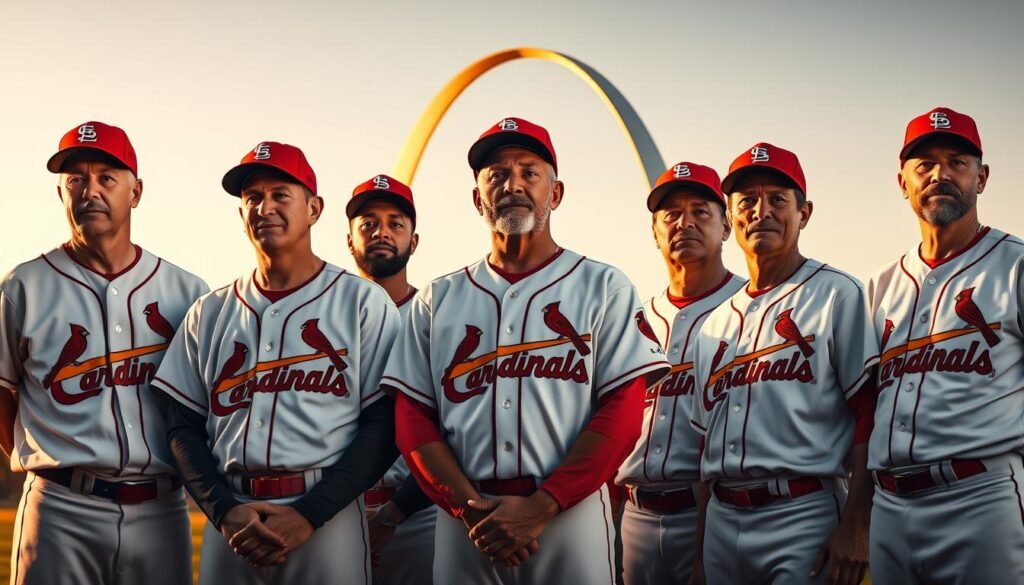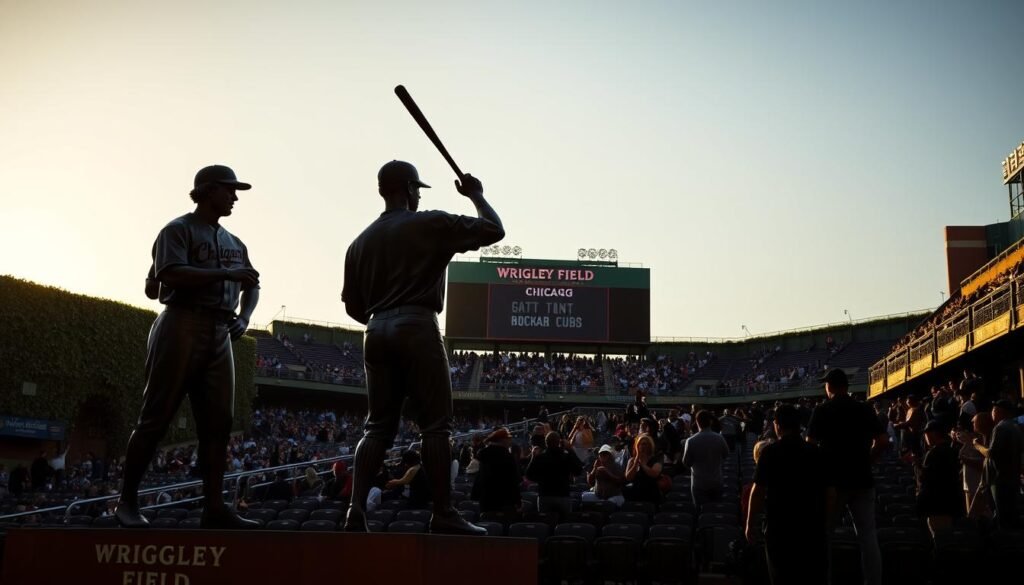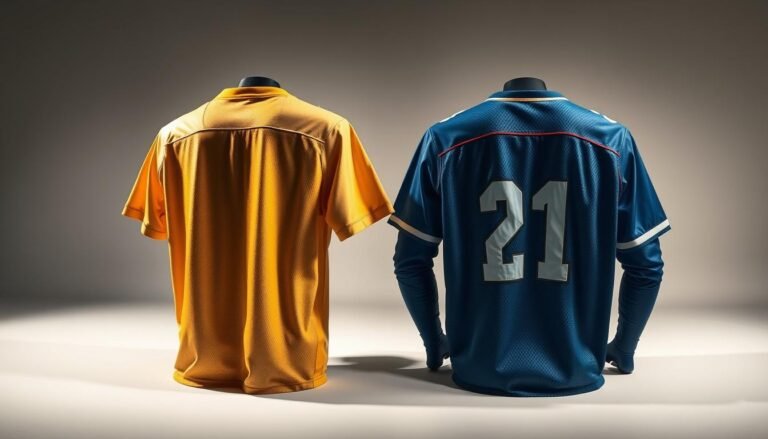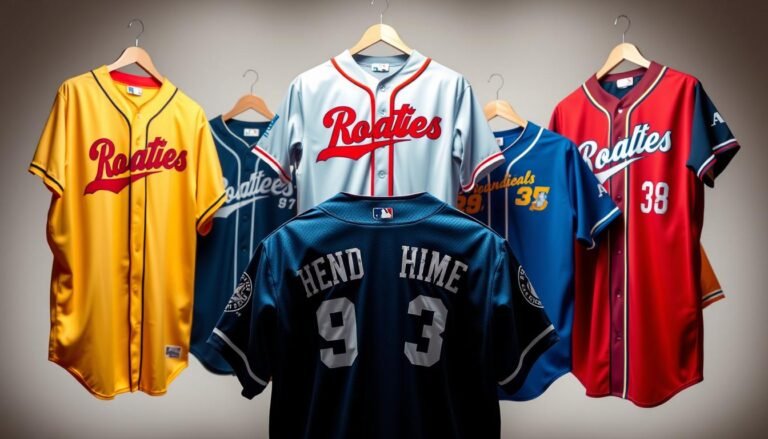Major League Baseball has a rich history of honoring its legends by retiring their jersey numbers, ensuring these iconic numbers are never worn again. This tradition pays tribute to the incredible contributions of baseball legends to the sport.
The practice of retiring jersey numbers is a significant way to remember the achievements of these athletes for generations to come. By exploring the stories behind these legendary numbers, we gain a deeper appreciation for the history and heritage of baseball.
Key Takeaways
- The tradition of retiring jersey numbers honors baseball legends.
- Retired numbers are never worn again by players.
- This practice preserves the history and heritage of baseball.
- Many iconic players have had their numbers retired.
- The retired jerseys are a testament to the players’ contributions to the sport.
- These legendary numbers continue to inspire new generations of baseball fans.
The Honor of a Retired Jersey in Baseball
The tradition of retiring jersey numbers in baseball is a testament to the lasting impact of legendary players. This honor signifies a player’s profound influence on the team and the sport as a whole.
What It Means to Have a Number Retired
Having a number retired is a prestigious acknowledgment of a player’s achievements and contributions to the team. It means that the number will never be worn by another player on the team, serving as a permanent tribute to the player’s legacy.
The History of Jersey Number Retirement in MLB
The history of jersey number retirement in MLB dates back to the early 20th century. The first team to adopt the practice of assigning numbers was the New York Yankees in 1929. By 1932, all major league clubs were issuing numbers, and by 1937, the leagues passed rules requiring it. The first major leaguer whose number was retired was Lou Gehrig in July 1939, marking the beginning of a tradition that would honor baseball legends forever.
The Most Retired MLB Jerseys Across the League
The retirement of jersey numbers in MLB is a tradition that honors the legends of the game. Certain numbers have become synonymous with excellence and are retired by teams to commemorate the achievements of their most iconic players.
Number 42: Jackie Robinson’s Universal Retirement
Jackie Robinson’s number 42 is perhaps the most iconic retired number in baseball. In 1997, MLB made history by retiring Robinson’s number across all teams, a testament to his groundbreaking career and impact on the sport. Robinson’s legacy extends beyond his on-field accomplishments, as he broke baseball’s color barrier in 1947, paving the way for future generations of players.
Other Commonly Retired Numbers in Baseball
While Jackie Robinson’s number 42 is universally retired, other numbers have also been retired by multiple teams. Numbers like 5, 24, and 31 are among those commonly associated with legendary players. The following table highlights some of the most commonly retired numbers and the players who wore them:
| Number | Player | Teams |
|---|---|---|
| 5 | Lou Gehrig | New York Yankees |
| 24 | Willie Mays | San Francisco Giants |
| 31 | Greg Maddux | Chicago Cubs, Atlanta Braves |
These numbers are a reminder of the incredible achievements of the players who wore them and the lasting impact they’ve had on the game.
New York Yankees: The Team with the Most Retired Numbers
With 21 retired numbers, the New York Yankees have the most in MLB, showcasing their legacy and commitment to honoring their legends. The Yankees have a rich history of producing iconic players who have left an indelible mark on the team and the sport.
The Legendary Number 3: Babe Ruth
Babe Ruth, known as “The Sultan of Swat,” is one of the most iconic figures in baseball history. His number 3 was retired by the Yankees in 1948, a testament to his enduring legacy. Ruth’s impact on the game extends beyond his impressive stats; he changed the way the game was played and perceived.
Number 4: Lou Gehrig and His Legacy
Lou Gehrig, “The Iron Horse,” was a stalwart for the Yankees, known for his consecutive games played streak and powerful hitting. His number 4 was retired in 1939, a rare honor at the time. Gehrig’s legacy extends beyond his on-field accomplishments, as his courage in the face of illness continues to inspire.
Number 7: Mickey Mantle’s Iconic Status
Mickey Mantle, a powerful switch-hitter, was a central figure in the Yankees’ success during the 1950s and 1960s. His number 7 was retired in 1969, recognizing his contributions to the team. Mantle’s legacy is complex, marked by both incredible talent and personal struggles.
Other Iconic Yankees Numbers Never to Be Worn Again
The Yankees have retired numerous other numbers, each telling a story of excellence and dedication. From Joe DiMaggio’s number 5 to Yogi Berra’s number 8, these players have become part of the fabric of the team’s identity.
| Player | Number | Year Retired |
|---|---|---|
| Babe Ruth | 3 | 1948 |
| Lou Gehrig | 4 | 1939 |
| Mickey Mantle | 7 | 1969 |
St. Louis Cardinals’ Immortalized Legends
With a legacy that spans decades, the St. Louis Cardinals have immortalized several of their most notable players by retiring their jersey numbers. This tradition not only honors the achievements of these legendary players but also serves as a reminder of the team’s rich history and the impact these individuals had on the franchise.

Number 1: Ozzie Smith’s Magic
Ozzie Smith, known as “The Wizard,” was a defensive wizard whose career with the St. Louis Cardinals is remembered fondly by fans. His number 1 jersey was retired in recognition of his incredible defensive skills and the significant role he played in the team’s success during his tenure.
Number 6: Stan “The Man” Musial
Stan Musial, affectionately known as “The Man,” had a storied career with the St. Louis Cardinals, earning numerous accolades and cementing his place as one of the all-time greats. His number 6 jersey was retired to honor his contributions to the team, both on and off the field.
Number 45: Bob Gibson’s Dominance
Bob Gibson was a force to be reckoned with on the mound, and his dominance was a key factor in the St. Louis Cardinals’ success during his playing days. The retirement of his number 45 jersey acknowledges his achievements and the lasting impact he had on the team.
Boston Red Sox Honored Numbers
The Boston Red Sox, one of the most storied franchises in Major League Baseball, have a tradition of retiring numbers to honor their greatest players. This practice not only pays tribute to the achievements of these athletes but also ensures that their numbers are remembered for generations to come.
Ted Williams’ Lasting Impact
Ted Williams, known as “The Splendid Splinter,” had a lasting impact on the Boston Red Sox. His number 9 was retired in 1984, recognizing his incredible career as a player and his contributions to the team. Williams is remembered for his hitting prowess and his service in World War II.
Carl Yastrzemski’s Legacy
Carl Yastrzemski, a legendary player for the Red Sox, had his number 8 retired in 1989. Yastrzemski’s career spanned over two decades, during which he achieved numerous milestones, including winning the Triple Crown in 1967. His dedication and achievements on the field have made him an icon in Red Sox history.
Pedro Martinez’s Pitching Brilliance
Pedro Martinez, one of the most dominant pitchers in baseball history, had his number 45 retired by the Red Sox in 2015. Martinez’s time with the Red Sox was marked by incredible performances, including a Cy Young Award in 1999. His legacy continues to inspire future generations of pitchers.
The Honor of a Retired Jersey in Baseball
In the world of baseball, retiring a jersey number is a rare and prestigious distinction reserved for the sport’s greatest icons. This honor signifies a player’s lasting impact on the team and the sport as a whole.
What It Means to Have a Number Retired
Having a number retired means that a player’s jersey number is no longer used by the team, serving as a permanent tribute to their achievements. This tradition not only honors the player but also inspires future generations.
The Significance of Retiring a Jersey Number
The act of retiring a jersey number is a significant gesture, acknowledging a player’s contributions to the team’s history and success. It’s a way to keep the player’s memory alive and to recognize their influence on the game.
The History of Jersey Number Retirement in MLB
The practice of retiring jersey numbers has its roots in the early 20th century. The first team to adopt this practice was the New York Yankees in 1929. By 1932, all major league clubs were issuing numbers, and by 1937, the leagues passed rules requiring it. Lou Gehrig was the first major leaguer whose number was retired in July 1939.
Early Examples of Jersey Retirement
Early examples of jersey retirement include iconic players like Lou Gehrig, whose number was retired by the New York Yankees. These examples set a precedent for honoring baseball legends and their contributions to the sport.
The Most Retired MLB Jerseys Across the League
The retirement of jersey numbers is a significant tradition in Major League Baseball, honoring the greatest players and their contributions to the sport. This practice not only pays tribute to the legends of the game but also serves as a reminder of their achievements to future generations.
Number 42: Jackie Robinson’s Universal Retirement
One of the most iconic numbers in baseball is number 42, worn by Jackie Robinson. In 1997, MLB retired Robinson’s number across all teams, a testament to his groundbreaking career and impact on the sport. Robinson’s legacy extends beyond his on-field accomplishments, as he broke baseball’s color barrier in 1947.
Other Teams That Have Retired Number 42
In addition to being retired league-wide, number 42 is also retired by numerous individual teams, a tribute to Robinson’s influence on the game. Many teams have also recognized other legendary players by retiring their jersey numbers.
Other Commonly Retired Numbers in Baseball
Other numbers, such as 5, 24, and 31, are also commonly retired across various teams. These numbers are associated with legendary players who have made significant contributions to their teams and the sport as a whole.
Examples of Players with Retired Numbers
Some examples of players with retired numbers include Babe Ruth (number 3), Lou Gehrig (number 4), and Mickey Mantle (number 7) of the New York Yankees. These players are remembered for their incredible achievements and lasting impact on their teams.
New York Yankees: The Team with the Most Retired Numbers
The New York Yankees are one of the most storied franchises in MLB, with a history that is reflected in their retired numbers. With a total of 21 retired numbers, the Yankees have honored some of the greatest players in baseball history. This legacy is a testament to the team’s success and the impact of these legendary players.
The Legendary Number 3: Babe Ruth
Babe Ruth is arguably one of the greatest baseball players of all time. His number 3 was retired by the Yankees in 1948, a year after he passed away. Ruth’s impact on the team was immense, with four home run titles and seven championships.
Babe Ruth’s Impact on the Yankees
Ruth’s legacy extends beyond his on-field accomplishments. He helped popularize baseball in the 1920s and 1930s, and his charismatic personality drew fans to the game.
Number 4: Lou Gehrig and His Legacy
Lou Gehrig, known as the “Iron Horse,” played in a record 2,130 consecutive games for the Yankees. His number 4 was retired in 1939, and he was inducted into the Hall of Fame in 1939. Gehrig’s durability and talent made him a beloved figure in Yankees history.
Gehrig’s Contribution to the Yankees
Gehrig’s contributions to the Yankees were significant, with six championships and seven All-Star appearances. His consecutive games played streak stood for over 70 years.
Number 7: Mickey Mantle’s Iconic Status
Mickey Mantle was a power-hitting outfielder who won three MVP awards with the Yankees. His number 7 was retired in 1969, and he was inducted into the Hall of Fame in 1974. Mantle’s legacy is complex, with both incredible talent and personal struggles.
Mantle’s Legacy with the Yankees
Mantle’s impact on the Yankees was significant, with seven championships and 20 home run titles. His legacy continues to be celebrated by Yankees fans today.
Other Iconic Yankees Numbers Never to Be Worn Again
In addition to Ruth, Gehrig, and Mantle, the Yankees have retired numbers for other legendary players, including Yogi Berra, Joe DiMaggio, and Derek Jeter. These players have all made significant contributions to the team’s history and success.
Examples of Other Retired Numbers
Other retired numbers include number 8 for Yogi Berra and Bill Dickey, and number 5 for Joe DiMaggio. These players are all Yankees legends, and their numbers will never be worn again.
St. Louis Cardinals’ Immortalized Legends
With a rich legacy in baseball, the St. Louis Cardinals have retired several iconic jersey numbers, paying tribute to the legends who have shaped the team’s history.
Number 1: Ozzie Smith’s Magic
Ozzie Smith, known as “The Wizard,” was a defensive genius whose career with the Cardinals was marked by incredible plays and numerous accolades.
Smith’s Impact on the Cardinals
Smith’s defensive prowess and charismatic personality made him a fan favorite, and his number 1 jersey is a testament to his lasting impact on the team.
Number 6: Stan “The Man” Musial
Stan Musial, affectionately known as “The Man,” was a hitting machine whose achievements on the field are still revered today.
Musial’s Legacy with the Cardinals
Musial’s legacy extends beyond his impressive stats; he embodied the spirit of the Cardinals, and his number 6 jersey retirement honors his contributions to the team.
Number 45: Bob Gibson’s Dominance
Bob Gibson was a force to be reckoned with on the mound, known for his fierce competitiveness and dominant pitching.
Gibson’s Contribution to the Cardinals
Gibson’s contributions to the Cardinals are immeasurable, and his number 45 jersey retirement is a nod to his significant role in the team’s success.
Boston Red Sox Honored Numbers
As one of the founding members of the American League, the Boston Red Sox have a long-standing tradition of honoring their most iconic players by retiring their jersey numbers. This practice not only pays tribute to the players’ contributions but also serves as a reminder of the team’s rich history.
Number 9: Ted Williams’ Lasting Impact
Ted Williams is widely regarded as one of the greatest hitters in baseball history. His number 9 jersey was retired by the Red Sox in 1984.
Williams’ Contribution to the Red Sox
Williams played his entire career with the Red Sox, earning two MVP awards and becoming a two-time All-Star. His legacy continues to inspire Red Sox players.
Number 8: Carl Yastrzemski’s Legacy
Carl Yastrzemski had a storied career with the Red Sox, playing for 23 seasons. His number 8 was retired in 1989.
Yastrzemski’s Years with the Red Sox
Yastrzemski’s contributions to the Red Sox include winning the Triple Crown in 1967. He was also a 18-time All-Star and was inducted into the Hall of Fame.
Number 45: Pedro Martinez’s Pitching Brilliance
Pedro Martinez is a legendary pitcher who played for the Red Sox from 1998 to 2004. His number 45 was retired in 2015.
Martinez’s Time with the Red Sox
Martinez’s time with the Red Sox was marked by incredible success, including winning the Cy Young Award in 1999 and 2000. He was instrumental in the Red Sox World Series victory in 2004.
| Player | Number | Year Retired |
|---|---|---|
| Ted Williams | 9 | 1984 |
| Carl Yastrzemski | 8 | 1989 |
| Pedro Martinez | 45 | 2015 |
“The Red Sox have a long history of honoring their players, and retiring numbers is a significant part of that tradition.”
Los Angeles Dodgers’ Retired Greats
The Los Angeles Dodgers have a storied history of retiring numbers in honor of their most legendary players. This tradition not only pays tribute to the individuals who have made significant contributions to the team but also serves as a reminder of the rich legacy that the Dodgers embody.
Number 32: Sandy Koufax’s Dominance
Sandy Koufax, one of the most dominant pitchers in baseball history, had his number 32 retired by the Dodgers. Koufax’s career was marked by numerous accolades, including multiple Cy Young Awards and World Series championships.
Koufax’s Impact on the Dodgers
Koufax’s impact on the Dodgers extends beyond his on-field achievements. He is remembered for his charismatic personality and his role in shaping the team’s identity during the 1960s.
Number 42: Jackie Robinson’s Brooklyn Legacy
Jackie Robinson, a trailblazer for racial integration in baseball, had his number 42 retired across all MLB teams, including the Dodgers. Robinson’s legacy with the Dodgers is a testament to his courage and determination.
Robinson’s Time with the Dodgers
Although Robinson’s most famous stint was with the Brooklyn Dodgers, his impact on the team and the sport as a whole cannot be overstated. He paved the way for future generations of players.
Number 2: Tommy Lasorda’s Managerial Impact
Tommy Lasorda, a beloved manager and figure in Dodgers history, had his number 2 retired. Lasorda’s leadership and managerial skills were instrumental in the team’s success during his tenure.
Lasorda’s Legacy with the Dodgers
Lasorda’s legacy extends beyond his managerial achievements. He is remembered for his passion, leadership, and the impact he had on the players he managed.
Chicago Cubs and Their Honored Heroes
The Chicago Cubs, a team with a storied past, have paid tribute to their most iconic figures by retiring their jersey numbers, a testament to the lasting impact these players had on the team.
Number 14: Ernie Banks – “Mr. Cub”
Ernie Banks, affectionately known as “Mr. Cub,” is one of the most beloved figures in Cubs history. His legacy extends beyond his on-field accomplishments.
Banks’ Legacy with the Cubs
Banks spent 19 seasons with the Cubs, earning numerous accolades, including two MVP awards. His contributions to the team are still celebrated today.
Number 10: Ron Santo’s Journey to Recognition
Ron Santo, a Hall of Fame third baseman, was honored for his dedication and skill. His number 10 jersey is now retired.
Santo’s Time with the Cubs
Santo played for the Cubs from 1960 to 1973, earning five Golden Glove awards and making nine All-Star appearances.
Number 31: Greg Maddux and Fergie Jenkins
The Cubs also retired number 31 in honor of both Greg Maddux and Fergie Jenkins, two pitching legends.
Maddux and Jenkins’ Contributions to the Cubs
Maddux and Jenkins are celebrated for their outstanding careers with the Cubs, with Maddux earning multiple Cy Young Awards and Jenkins winning the Cy Young Award in 1971.

San Francisco Giants’ Legendary Numbers
The San Francisco Giants have honored some of baseball’s greatest players by retiring their jersey numbers. This tradition highlights the significant contributions these players made to the team.
Number 24: Willie Mays’ Incredible Career
Willie Mays is one of the most iconic players in Giants history. Known as “The Say Hey Kid,” Mays had an illustrious career with the Giants, earning numerous accolades and cementing his legacy as one of baseball’s all-time greats. Mays’ career was marked by incredible achievements, including multiple MVP awards and a World Series championship.
Mays’ Impact on the Giants
Mays’ impact on the Giants cannot be overstated. He was a key figure in the team’s success during his playing career, known for his exceptional defensive skills and powerful hitting. As legendary baseball historian John Shea once said, “Willie Mays was the heart of the Giants,” highlighting his importance to the team’s identity.
Number 44: Willie McCovey’s Power Legacy
Willie McCovey, also known as “Stretch,” was a dominant force at the plate. His power-hitting legacy continues to be celebrated by the Giants, with McCovey earning numerous awards and setting multiple records during his career. McCovey’s presence in the Giants’ lineup was a game-changer, providing a potent threat that opposing teams feared.
McCovey’s Contribution to the Giants
McCovey’s contributions to the Giants include numerous records and accolades, cementing his place in the team’s history. As noted by
“Willie McCovey was a giant at the plate,”
, underscoring his impact on the game.
Number 27: Juan Marichal’s Hall of Fame Career
Juan Marichal was a Hall of Fame pitcher known for his dominance on the mound. His career with the Giants is still revered today, with Marichal being remembered for his skill and tenacity as a pitcher. Marichal’s Hall of Fame career was highlighted by his impressive win-loss record and numerous awards.
Marichal’s Legacy with the Giants
Marichal’s legacy extends beyond his playing career, as he is remembered for his sportsmanship and dedication to the game. The Giants continue to honor Marichal’s legacy, recognizing his significant contributions to the team’s history.
Other Teams with Significant Retired Numbers
MLB’s tradition of honoring players by retiring their numbers is evident in teams beyond the most well-known franchises. Several teams have celebrated their history by retiring numbers for iconic players.
Cincinnati Reds: The Big Red Machine Era
The Cincinnati Reds, known for their dominant “Big Red Machine” era, have retired numbers in honor of their legendary players. This era was marked by incredible talent and numerous achievements.
The Reds’ Most Iconic Players
Players from this era have been immortalized with retired numbers, reflecting their significant contributions to the team’s success.
Atlanta Braves: Hank Aaron’s Number 44
The Atlanta Braves have also honored one of baseball’s all-time greats, Hank Aaron, by retiring his number 44. Aaron’s legacy with the Braves is still celebrated today.
Aaron’s Legacy with the Braves
Aaron’s achievements with the Braves are a significant part of the team’s history, and his number 44 is a lasting reminder of his impact.
Detroit Tigers: Al Kaline and Ty Cobb
The Detroit Tigers have retired numbers for two of their most iconic players, Al Kaline and Ty Cobb. Both players have left a lasting legacy with the team.
Kaline and Cobb’s Contributions to the Tigers
Kaline and Cobb’s contributions to the Tigers are still remembered and honored today, reflecting their importance to the team’s history and identity.
The Process of Retiring a Jersey Number
The process of retiring a jersey number involves a formal ceremony and specific criteria, varying across MLB teams. This tradition is a significant honor, reflecting a player’s contributions and achievements.
Team Criteria for Jersey Retirement
Each MLB team has its own criteria for retiring jersey numbers. Some teams require a player to have achieved certain milestones, such as being inducted into the Hall of Fame or having a significant impact on the team’s history.
Examples of Teams with Strict Criteria
For instance, some teams have strict criteria that include a combination of on-field achievements and community involvement. The New York Yankees, for example, have retired numbers for legendary players like Babe Ruth and Lou Gehrig.
The Ceremony and Tradition
The ceremony for retiring a jersey number is a solemn occasion, often attended by the player, their family, and team officials. It’s a celebration of the player’s legacy and contributions to the team.
The Significance of Retirement Ceremonies
These ceremonies are significant because they not only honor the player but also serve as a reminder of the team’s history and heritage.
Special Cases and Controversies in Jersey Retirement
While jersey retirement is a revered tradition, it also encompasses special cases and controversies. The honor of having a jersey number retired is not limited to players alone, and there are instances where non-players have been recognized in this way.
Retiring Numbers for Non-Players
In some cases, teams have retired numbers or honored individuals who were not players. This can include managers, owners, or other significant figures in the team’s history.
Examples of Non-Players with Retired Numbers
For instance, the Brooklyn Dodgers honored Walter O’Malley, their former owner, with a special badge. Similarly, the San Francisco Giants recognized Willie McCovey not just for his playing career but also for his impact on the organization.
Debated Retirements and Near-Misses
Not all jersey retirements are universally agreed upon. Some players and fans debate the merits of certain retirements, arguing that others should have been recognized instead.
Controversial Cases of Jersey Retirement
A notable example is the debate surrounding Pete Rose‘s potential jersey retirement. Despite his achievements on the field, his ban from baseball has complicated discussions around honoring him.
MLB vs. Other Sports’ Retirement Practices
The practice of retiring jersey numbers varies across different sports leagues. MLB’s tradition is distinct, with a strong emphasis on honoring individual achievements and contributions to the team.
Comparisons with Other Leagues
In comparison, the NBA and NFL also retire jersey numbers, but the criteria and ceremonies can differ significantly. For example, the NBA’s Los Angeles Lakers have retired several numbers, including those of Kobe Bryant and Magic Johnson, with elaborate ceremonies.
| League | Jersey Retirement Criteria | Notable Examples |
|---|---|---|
| MLB | Significant contributions, achievements | Jackie Robinson (#42), Babe Ruth (#3) |
| NBA | Notable players, significant team impact | Kobe Bryant (#8, #24), Magic Johnson (#32) |
| NFL | Exceptional players, team legends | Joe Namath (#12), Walter Payton (#34) |
Conclusion: The Enduring Legacy of Retired MLB Jerseys
The tradition of retiring jersey numbers in MLB is a lasting tribute to the sport’s legends, creating a rich MLB jersey legacy that continues to inspire new generations of baseball fans. As we reflect on the numbers retired and the stories behind them, we appreciate the impact these baseball legends have had on the game.
From the iconic numbers worn by Babe Ruth and Jackie Robinson to the more recent retirements honoring players like Pedro Martinez and Ozzie Smith, each retired jersey tells a story of excellence, dedication, and passion. These numbers are a reminder of the incredible achievements of baseball legends and the lasting impact they have had on their respective teams and the sport as a whole.
The legacy of retired MLB jerseys serves as a connection to the past, while also inspiring future generations of players and fans. As the game continues to evolve, the stories and memories associated with these legendary numbers will remain an integral part of baseball’s heritage, ensuring the MLB jersey legacy endures for years to come.





